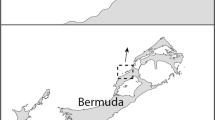Abstract
The sea urchin, Lytechinus variegatus, has been estimated to consume between 50 and 90% of annual net aboveground production in selected turtlegrass (Thalassia testudinum) meadows in the eastern Gulf of Mexico. Nevertheless, turtlegrass persists where sea urchin grazing is intense. We hypothesized that turtlegrass productivity is stimulated by grazing, as has been reported from terrestrial grassland systems, and that this best explains the persistence of heavily grazed turtlegrass in St. Joseph Bay, Fla. This hypothesis was tested by manipulating sea urchin densities (0, 10, and 20 individuals/m2) in 1-m2 enclosures. These densities encompass the range of average densities at the study site and those reported in the literature. Changes in turtlegrass abundance (e.g., short shoot density and biomass), production by short shoots, and leaf width were monitored in these enclosures during the summer. Repeated-measures ANOVA showed that production by short shoots, leaf density/shoot, and leaf width decreased over time in all treatments. Leaf density/shoot and leaf width were not significantly impacted by grazing, nor did grazing significantly reduce seagrass biomass, but it did lead to significantly higher densities of short shoots than found in control cages. Our results indicate that turtlegrass compensates for the effects of sea urchin herbivory by increasing the recruitment of short shoots during the growing season. We estimate that this increased shoot density led to a 40% increase in net aboveground primary production (g dry weight/m2) in grazing treatments, which helps to explain the lack of significant reductions of sea grass biomass during the growing season.
Similar content being viewed by others
Author information
Authors and Affiliations
Additional information
Received: 26 April 1995 / Accepted: 29 May 1997
Rights and permissions
About this article
Cite this article
Valentine, J., Heck, K., Busby Jr., J. et al. Experimental evidence that herbivory increases shoot density and productivity in a subtropical turtlegrass (Thalassia testudinum ) meadow. Oecologia 112, 193–200 (1997). https://doi.org/10.1007/s004420050300
Issue Date:
DOI: https://doi.org/10.1007/s004420050300




